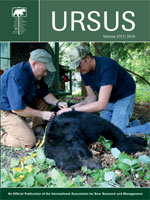Recent advances in genetic approaches have facilitated genetic marking in capture–recapture (CR) experiments. Individuals can now be identified through non-invasive sampling and multi-locus genotyping instead of physical capture. In non-invasive studies where collection sites are used, detection depends on whether (1) an individual deposits a sample at the collection site, and (2) an individual can be genetically identified from the sample. Here we evaluate factors influencing detection of grizzly bears (Ursus arctos) at hair-sampling sites from 4 genetic CR projects (2006–2012) in British Columbia, Canada, and provide recommendations for maximizing detection in future studies. We found significant effects of trap type (bait site vs. rub object), sex, and season on the detection of grizzly bears. Bait-site detection was approximately 5-fold greater than detection at rub objects; and bait sites generally detected the sexes equally, whereas rub-tree detection was strongly male-biased. At rub objects, males had a 7-fold greater detection during the breeding season compared with females. Genotyping success increased with the number of hair follicles in the sample and decreased with the duration between trap checks. Rainfall was correlated with trap duration and was also negatively related to genotyping success. Samples with little genetic material (<2 guard hair, or <15 underfur) had low genotyping success and are best avoided, especially if samples with more follicles exist. Rub objects are an efficient sampling method but we caution investigators that these traps, unless deployed in large numbers, imperfectly detect female bears. The combined effect of trap type, sex, and season on a bear visiting a site, paired with the effects of hair quality, quantity, and sampling duration or rainfall on genotyping success, produced a range of detection spanning 2 orders of magnitude, highlighting the imperative for investigators to consider these factors for CR projects.
How to translate text using browser tools
1 May 2016
Factors influencing detection of grizzly bears at genetic sampling sites
Clayton T. Lamb,
Dustin A. Walsh,
Garth Mowat
ACCESS THE FULL ARTICLE

Ursus
Vol. 27 • No. 1
May 2016
Vol. 27 • No. 1
May 2016
bait site
capture heterogeneity
capture–recapture
genotyping success
mark–recapture
non-invasive sampling
population estimation




